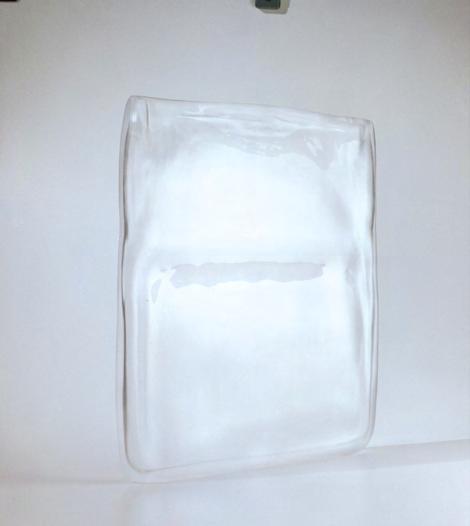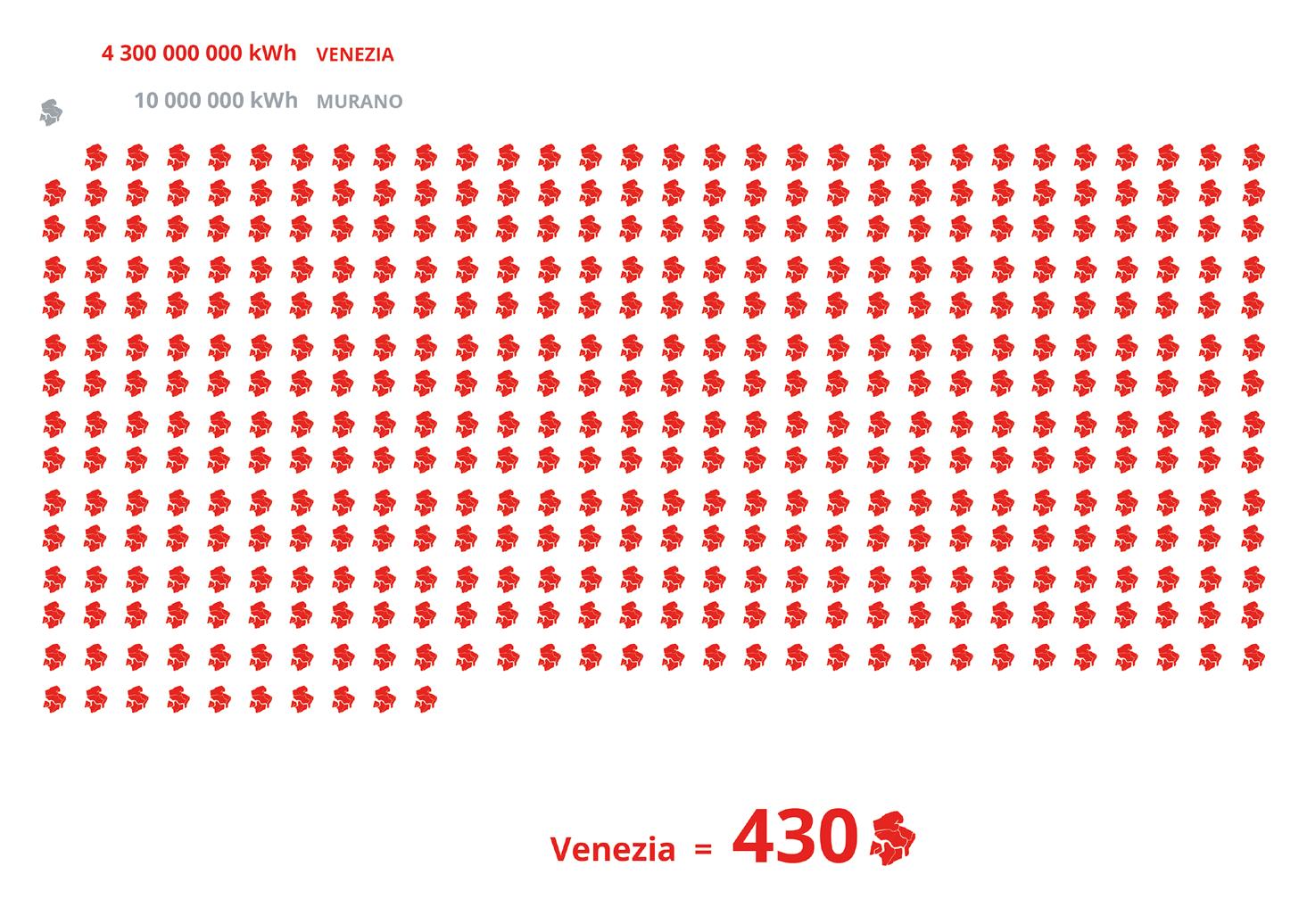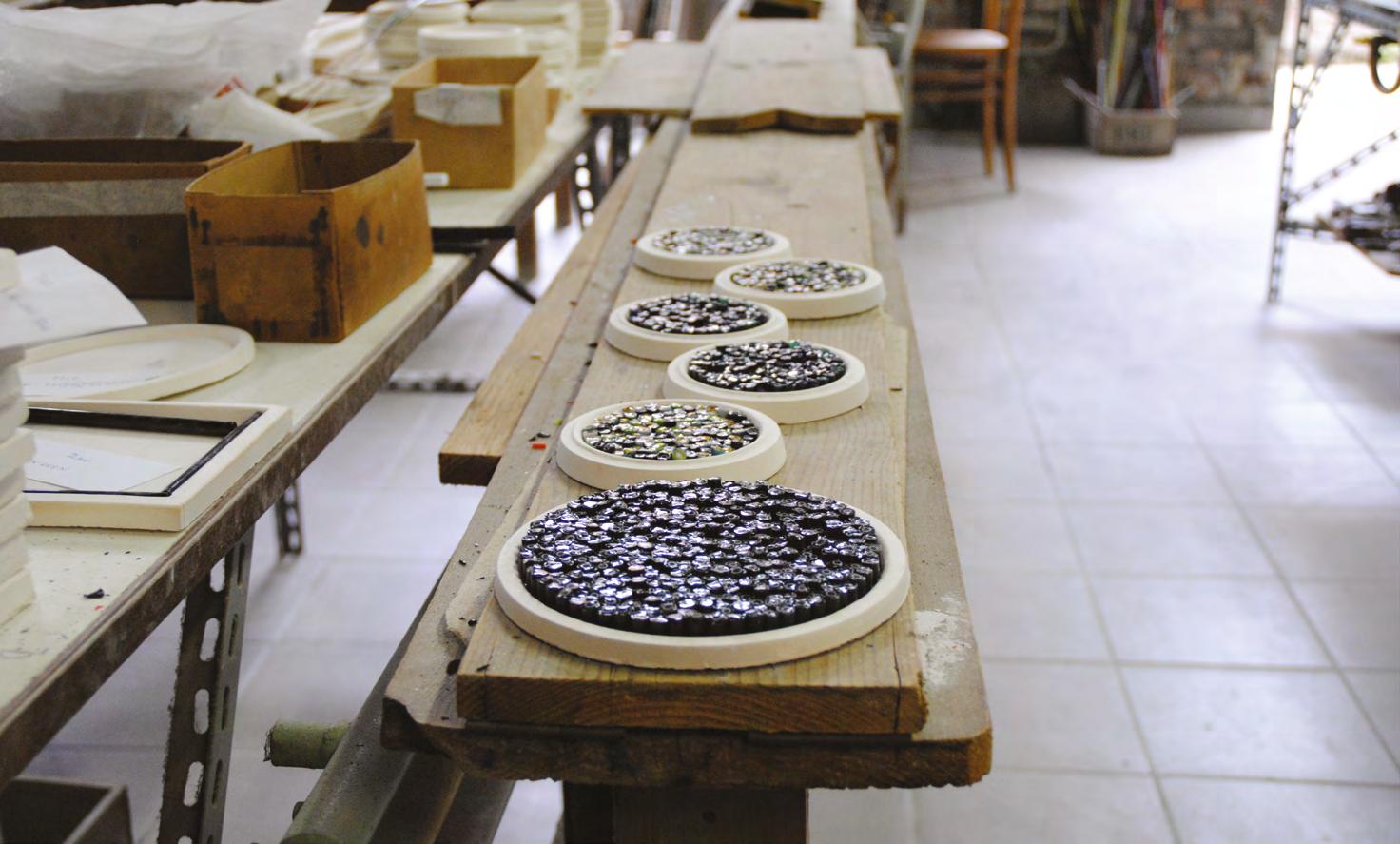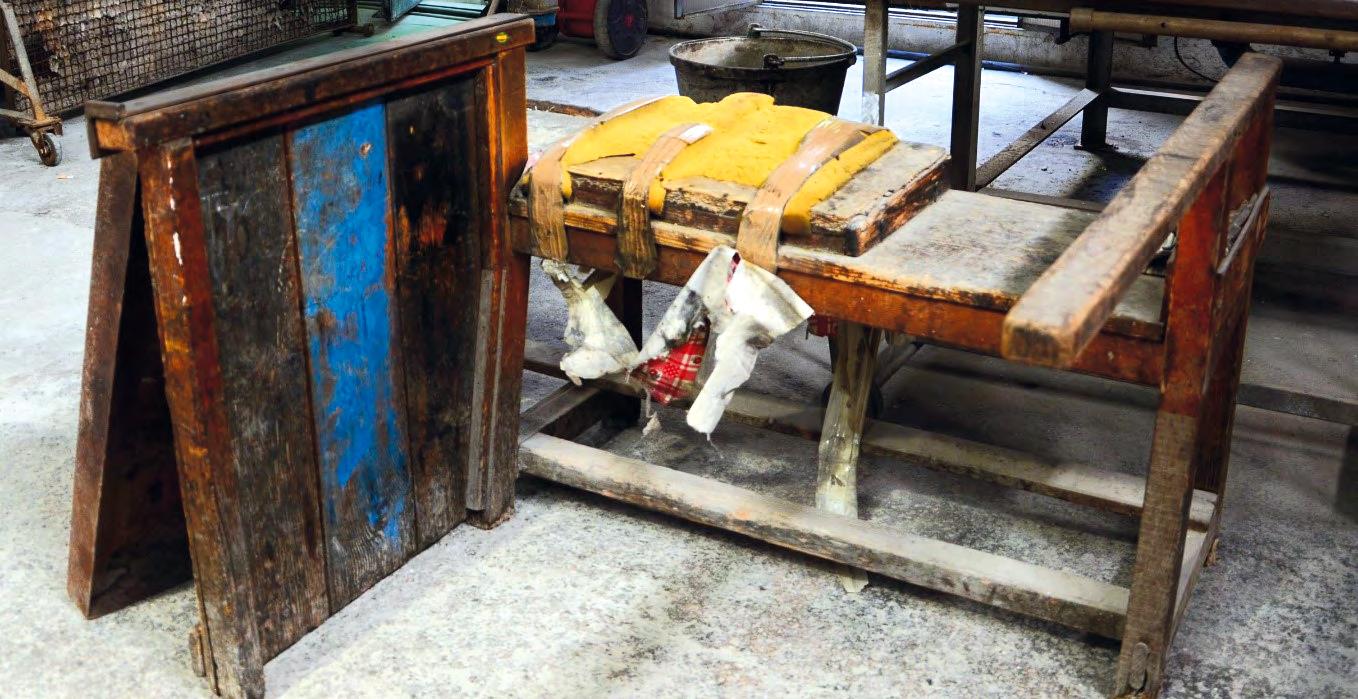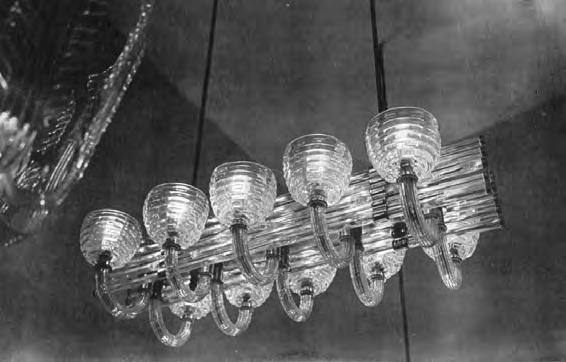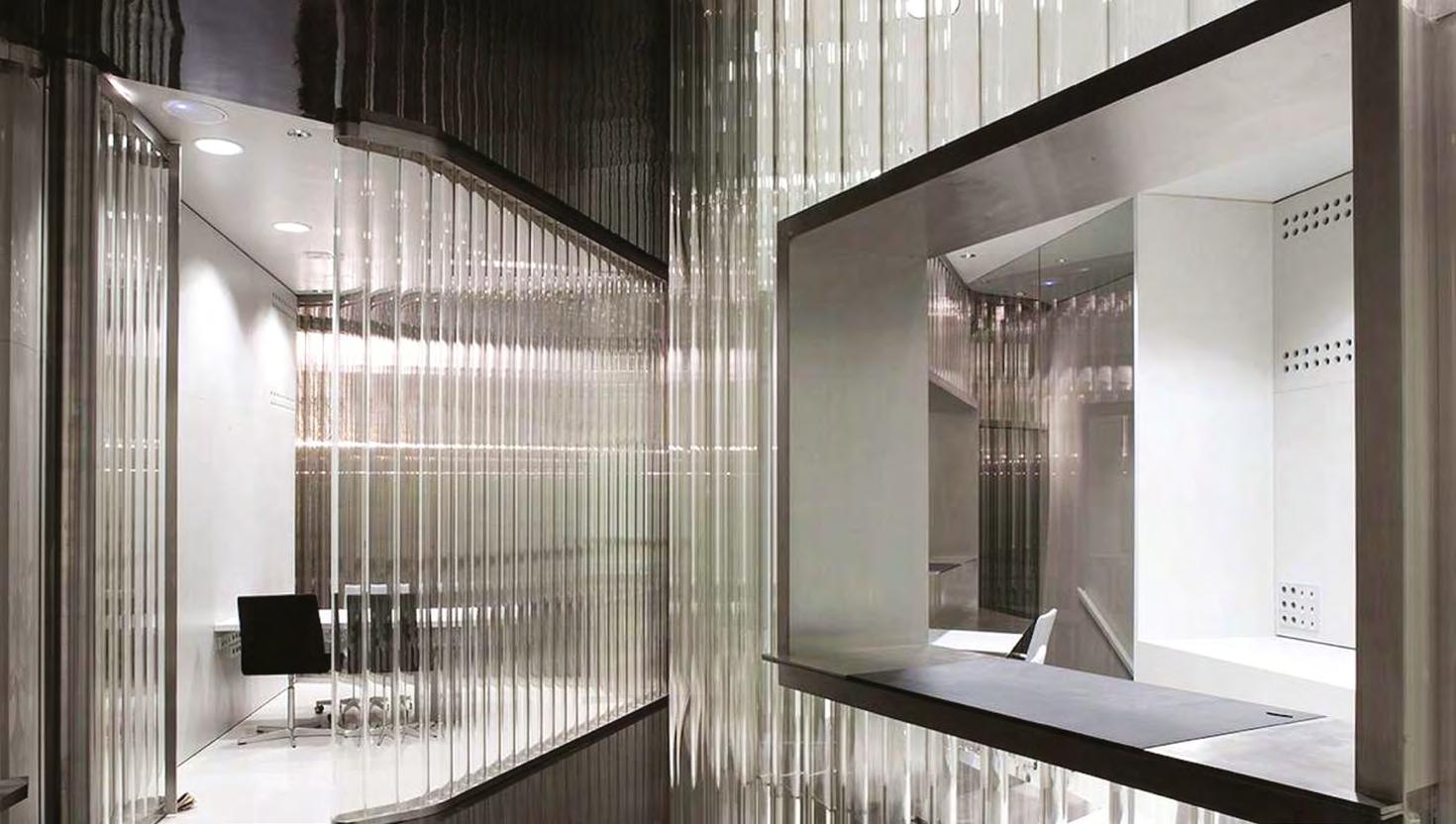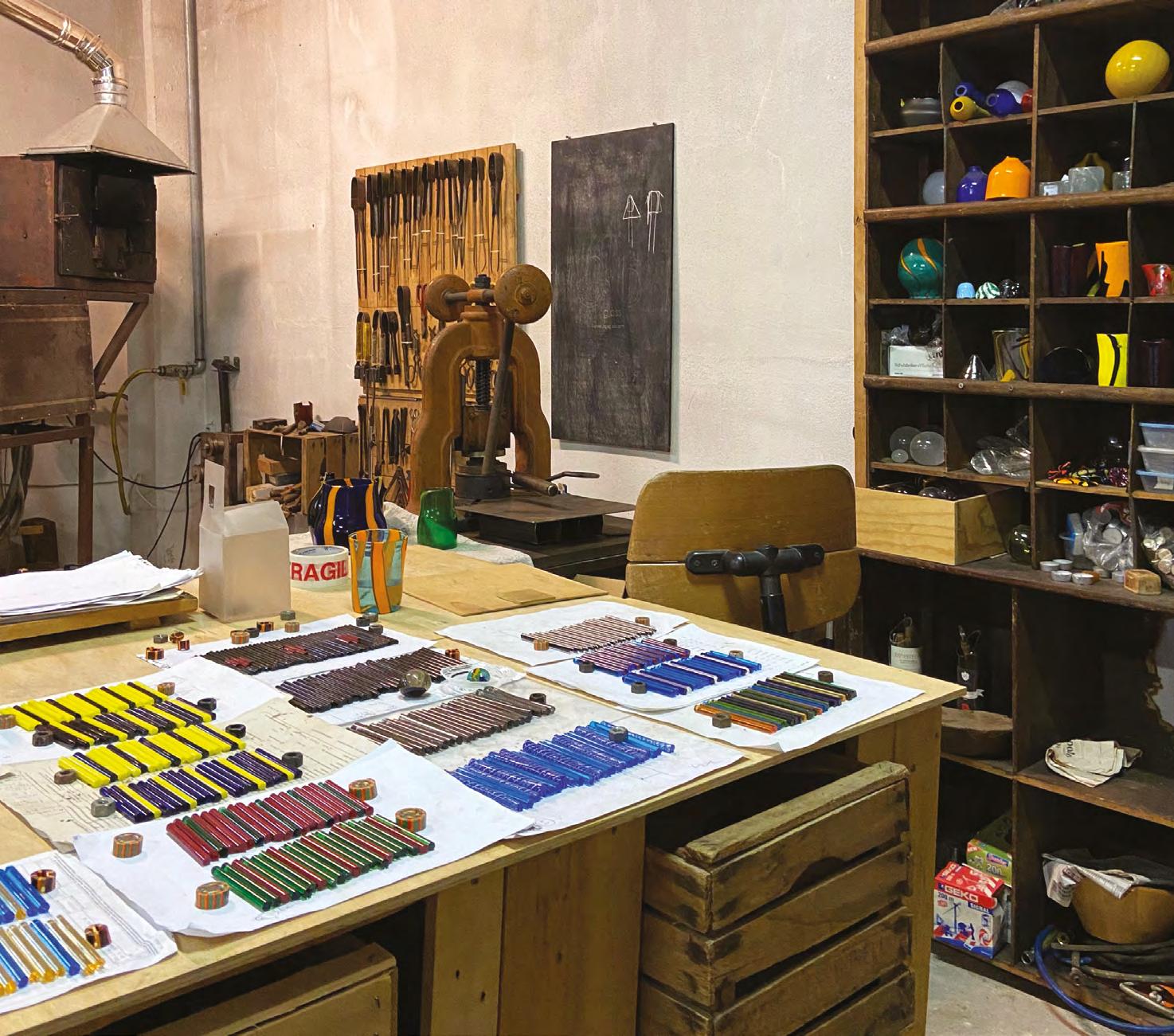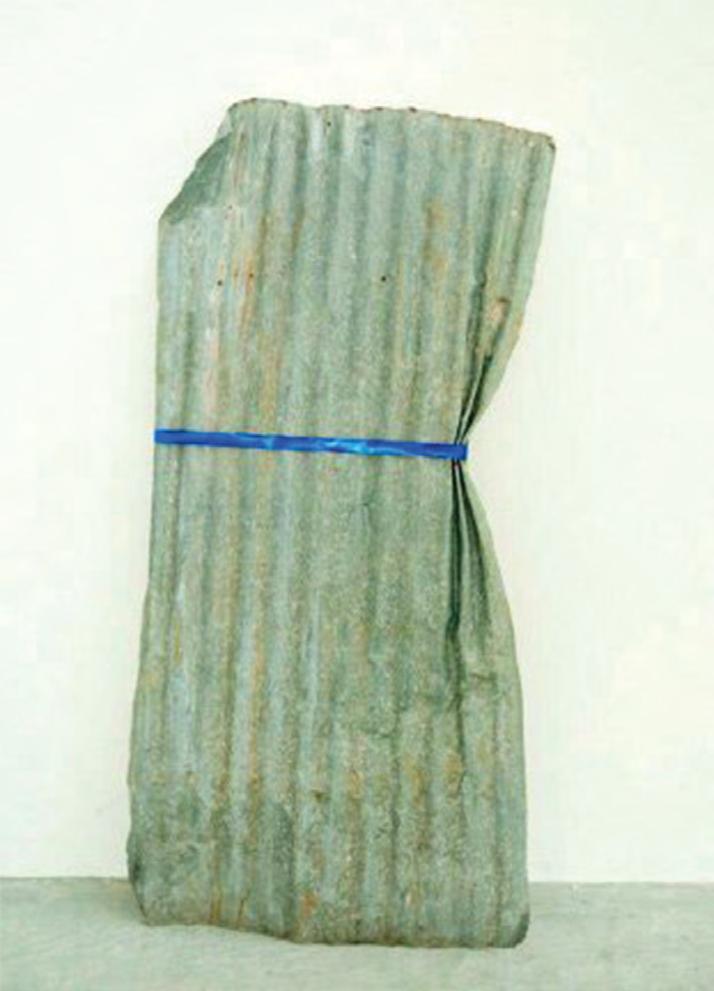
18 minute read
From industrial float glass to collectible design: the
From industrial float glass to collectible design: the functional light sculptures Baracche, project by artist Paolo Gonzato
BEATRICE BIANCOA, MARINELLA FERRARAB
KEYWORDS: COLLECTIBLE DESIGN, INDUSTRIAL MATERIAL, FLOAT GLASS
In the panorama of the today Expanded Design, the connection design-craft, is promising in the perspective of the development of Creative Industries and economies in Italy. This paper brings the direct experience of intersection between the industrial and standardised material float glass, the creative approach of artist Paolo Gonzato on this material to create unique light glass sculptures and all the process related to them. It will encompass the qualities of the glass and the specific production process that characterize it, with the possibilities related to its functional features. It will investigate the phenomenon of the creative process that sees the transformation of such material from an architectural – construction element to a unique artwork, realised in a craft environment.
A IED Turin, Italy. B Politecnico di Milano, Italy.
Introducing the material
The making process of float glass is an example of industrial and large-scale production. Invented in the ‘50 by Alastair Pilkington and Kenneth Bickerstaff in England, the aim was to obtain flat or smooth sheets of glass without resorting to costly operations to remove abrasions (Pilkington, 1969).
This radical technological change was quickly adopted by the plate glass industry, where it eliminated the labor-and cost-intensive grinding and polishing production phases. Sheet glass was a cheaper product, and its manufacturing process did not require as huge capital investments as were needed in the plate glass industry. However, float glass gradually entered the sheet glass markets as well and finally the float glass process replaced the existing drawing methods (Uusitalo, 2014).
Pilkington’s discovery of float glass forced other glass manufacturers in the ‘60 to switch production techniques almost overnight and the high cost of installing new plant meant that only larger, cash rich organizations could survive. The result has been to increase the concentration of manufacturing power within a small group of companies operating out of the UK, France, Japan, and the US (Taylor, 1979).
Even though the production of flat glass is one of industrial processes at higher temperatures, it represents only 0.65% of emissions industrial CO2 of the EU16 (Glass for Europe 2020), with a 100% recyclable material.
In Italy most of the distributed float glass comes from St. Gobain and Pilkington, as major glass producers in Europe.
The process
The main components used for the manufacture of “Float” glass are, Silica sand (73%), Calcium Carbonate (9%), Sodium Sulphate (13%).
Once dosed and mixed, a certain mass is added to these components of recycled glass, in fragments, to reduce the gas consumption of the furnaces of Merger. The mixture of raw materials, properly dosed in a silo, passes on a conveyor belt and is fed into a five-sided melting furnace chambers where it is brought to a temperature of about 1,200° C.
At the exit from the melting furnace the mass of molten glass is brought to float on the surface of a molten tin bath, at a temperature of about 1,000° C The glass which at this temperature is very viscous and the tin which instead is very fluid do not mix and the contact surface between the two elements is perfectly flat and smooth.
The glass thus forms a “ribbon” of 3.21 m in width with a thickness that it can vary from 3 to 19 mm. The glass leaves the tin bath at a temperature of about 600° C and enters, now in the solid state, in an annealing chamber passing on a series of rollers. This step of the manufacturing process serves

Fig. 01 Inspirational work by Paolo Gonzato. Courtesy Paolo Gonzato Fig. 02 Drawing of twisted metal sheet by Paolo Gonzato. Courtesy Paolo Gonzato
to change the voltages internal allowing that the glass ribbon, made flat, can be cut into plates without problems the two surfaces of the glass ribbon are perfectly smooth and shiny and not need no further finishing.
At the end of the cooling phase, the glass strip is subjected to a series of very strict controls; then it is washed and dried at this point it is cut into “Cast Plates” having dimensions of 3.21 x 6 m (Ferreira Nascimento, 2014).
Brief colouring elements
During the process the glass can be treated with minerals and metals like chromium or copper, to give colours to the dough. Iron is one of the most used metals, producing several shades of green – depending on the iron concentration and ion ratio, ultraviolet control, and infrared transmission. Amber colouring is normally used to prevent ultraviolet damages of the contents and is the result of an iron-sulphur chromophore. Highly oxidized glass is an unpleasant yellow green.
Metallic colloids (Au, Cu) dispersed in glasses are the primary source of red glasses. Silver colloids produce a variety of yellow to brown colours. Colloidally coloured glasses have been produced for around 2000 years for art objects and are still routinely used by glassblowers and other glass artists. Other metallic colloids produce either grey to black (Pb, Co, Ni, In, Bi) or brown to black (As, Sb) glasses.
Since the invention of the Pilkington float glass process in the ‘50 enabled the production of float glass with standardized quality, architects and engineers have pushed glass technology for maximizing size and transparency, nurturing a building culture of minimal material presence and maximal transparency in the glass. Meanwhile, multi-coloured glass has been rarely implemented in construction and so in the float process. This is due to the labor intensiveness of the manual crafting process, which results in high costs and non-standardized quality, and the lack of automated methods for manufacturing polychromatic glass at the construction scale. (Giesecke et al., 2022).
From functional needs to aesthetic fruition: the work of Paolo Gonzato on float glass
In 2016 Camp Design Gallery, Italian collectible design gallery based in Milan, founded by me and my former associate Valentina Lucio, participated to the former design fair Operae in Turin, where the gallery was invited to the program Piemonte Handmade. The aim of the program was to connect the figure of the gallery, an invited artist or designer, and a well-known artisan in the productive network of the Turin area.
Paolo Gonzato, Milanese artist, was invited to work with an assigned industrial glass artisan called Cristal King. It was the first time that the artist was called to work such material.
He took confidence with the different types of glasses like the cathedral type or the float glass and the techniques that the artisans use to work it: mostly cuts and assemblage and the thermos-forming through industrial ovens. After several experiences, the option was to use the float glass, thanks to its resistance properties and the possibility to thermos-sculpting it.
The formal and aesthetic research of Paolo Gonzato lies on the contemplation and crystallisation of leftovers and borders, forgotten objects and poor materials. Travelling from Milan to Turin gave the artist the possibility to observe the borders of the cities and notably the metal shacks. Moreover, the industrial environment of the artisan’s factory, gave to the artist the impulse to use exclusively industrial materials for the creation of unique pieces of collectible design: a lightened glass sculpture.
The conceptual process
As aforementioned, Paolo Gonzato’s research is part of an active and daily aesthetic, of collecting and manipulating objects of common use if not waste, exercising an Aesthetic of Existence, as defined by Michel Foucault (1998, p. 27), where “the action of self-creation takes place through the exercise of criticism and care”, in the search for a balance and one’s own order in the world, which
seems to work even in marginal contexts (Lunghi and Trasforini, 2010). In this context Gonzato develops his aesthetic of the forgotten, that includes physical and mental margins, leftovers, to give dignity and beauty to what is voluntary not seen and retained by society. Like Bell Hooks, that defined “aesthetics of existence”, the ability to experience beauty as a form of resistance to social marginalization and the impoverishment of the spirit (1998).
The following text has been written by Damiano Gullì, Art and Public Program Curator at the Triennale Milano, invited by the artist and the gallery to summarise the Baracche project in the occasion of the second solo show displayed at Camp Design Gallery in September 2020.
“baracca s. f. [from Catalan barraca (probably pre-Roman voice), through the Spanish]. – 1. Tem¬porary construction, general of wood with metal sheet or asbestos cover, for sheltering people or goods.
In 1906 Giuseppe Ungaretti met Enrico Pea, poet, writer, dramatist, and theatrical impresario, who recently moved to Egypt, with whom gave life to the Baracca Rossa, a marble and timber warehouse that soon became the venue for meetings for an archists and socialists. But not only. Here Ungaretti had the opportunity to get in touch with several intellectuals and writers from all over the world, essential for his educational enrichment.
The cabin is therefore a physical place and at the same time a metaphor for a relational and cre¬ative process poised between anarchy and control, poetry, and rationality. But still with hum¬ble, precarious roots, marked by transience.

Fig. 03 The artist Paolo Gonzato studying the material and its possible solutions. PEPE fotografia
Unlike the hut-sophisticated machine-à-habiter (think of Le Cabanon by Le Corbusier), an intellectual shelter, an ideal existenzminimum – the hut conceals, not too subtly, the prodromes of imperfection, imbalance, fragility.
When in 2016 Paolo Gonzato designed the first series of Baracche as part of Operae in Turin – a brilliant dialogue between the designer, Camp Design Gallery in Milan, and the artisan know-how of the Turin glass factory Cristal King – he had a very specific vision in mind: “Instant ar¬chitecture”, “bric-à-brac constructions”.
By carrying out an operation of appropriation and decontextualization (sometimes forcing the technical-executive limits) Gonzato isolates a part of the whole – the corrugated sheet metal constituting the roof of the hut – creating it a luminous body, changing its axis and inclination, making it sculptural. He monumentalizes, ennobles, transforms, and dramatizes scraps and preexisting fragments, initially poor, and translates them into precious glass. This action of recovery, transformation, and transmutation of materials whether paper, ceramic, marble, or glass, in fact – is recurrent in Gonzato’s practice, already evident in one of his first works in 2001, part of the series The Sound of Ego: a bale of hay wrapped in a hot pink satin ribbon. Is it a sculpture of a poor nature in salsa camp? A seat reminding the Straw Chair by Alessandro Mendini from 1975? An ironic fake Christo packaging? Glamor that envelops the bucolic, high and low merge. Cheap and chic, one might say, to take up the name of the famous perfume – almost a claim – by Moschino, surely one of the references of the artist and de- signer for the subversive design approach. Gonzato plays and slides between disciplines and techniques – from art to fashion to design, from painting to installation – while maintaining constant rigor and consistency. He assimilates and makes his own from the lessons of some Italian Masters, whom he loved, also elusive to rigid categorizations and disciplinary hierarchies. In his works the Pontian decoration echoes – and how not to think of the lozenge, an element taken from the costume of Arlecchino, reiterated in numerous paintings and collages by Gonzato – the charm of Pesce’s imperfection, the anthropology of Mendini’s objects, Munari’s aleatory nature, Sot¬tsass’s eroticism and sacredness.
With his Baracche Gonzato outlines an aesthetic of precariousness, marginality – “a smoothie of brutalism and mall ruins, Baracche is the semantic reduction from a house to a caricature”, in the artist’s words that can be placed in an open path from the simulacra of construction sites of the installation L’isola delle rose of 2012 or Achtung! Frisch Gestrichen of 2015. A fascination for ruin and transient that is also found in the recent studies on Giambattista Piranesi merged into the Pastiche series of ceramics of 2020.
With his new Baracche, Gonzato resumes and expands previous research, coming to deal with the type of chandelier to re- semantize it in a goliardic and grotesque key.
Finally, I like to think of a vernacular regional connotation of the expression
“fare shack”, which means “partying”, but also “making noise, confusion”.
It is the perfect translation of Gonzato’s work. The chaotic joy of designing.”
Damiano Gullì (curatorail text for Baracche 2020, Camp Design Gallery).
Reception, public and market
Since its first show at Operae 2016, the Baracche project received a vivid welcome from the public and the design press. This brought to realise an entire solo show of Paolo Gonzato’s Baracche collections in January 2017 and a second one in September 2020, both at Camp Design Gallery. Moreover, Baracche has been shown in Paris, during the Paris Design week 2020 and at Collectible Design Fair in Brussels both in 2018 and 2020. Among the two collections several commissioned pieces have been created during these years, thanks to the craft approach of the project where every piece is entirely hand made and unique in shape. The reference markets are the collectible design field and the high-end craft market which is composed by a strong niche of private collectors, architects, and interior design studios, on national and international scale.
Craft and handmade design projects like Baracche concern to the collectible design and luxury market as they can provide work and beneficial specialization in the craft sector. Italy has an important craft network to rely on and able to absorb experimental approaches, as we will see in the next paragraph.
Behind the design work
The process for the creation of such piece involves several professional figures that accompany the artist: • The gallery project manager, that coordinates the artist and the artisans with timing and calendars. • The glass supplier (a company can’t directly buy glass from the wholesale chain, there’s the distributor that intermediates for it). • The glass artisan that assists the artist during the preparation of the sculpture. • The led and transformer supplier. • The smith that works industrial reinforcing bars as hanging custom prong that holds the glass sculpture. • The electrician that instal the led and its transformer. • The crate supplier for national and international transports. • The shipping companies for the work destination.
Emanuele Quinz opens is text Contro l’Oggetto (2020) with a peculiar observation: in Italy there is not only a great tradition of design, but also a great tradition of design definitions. One of the most triggering ones is
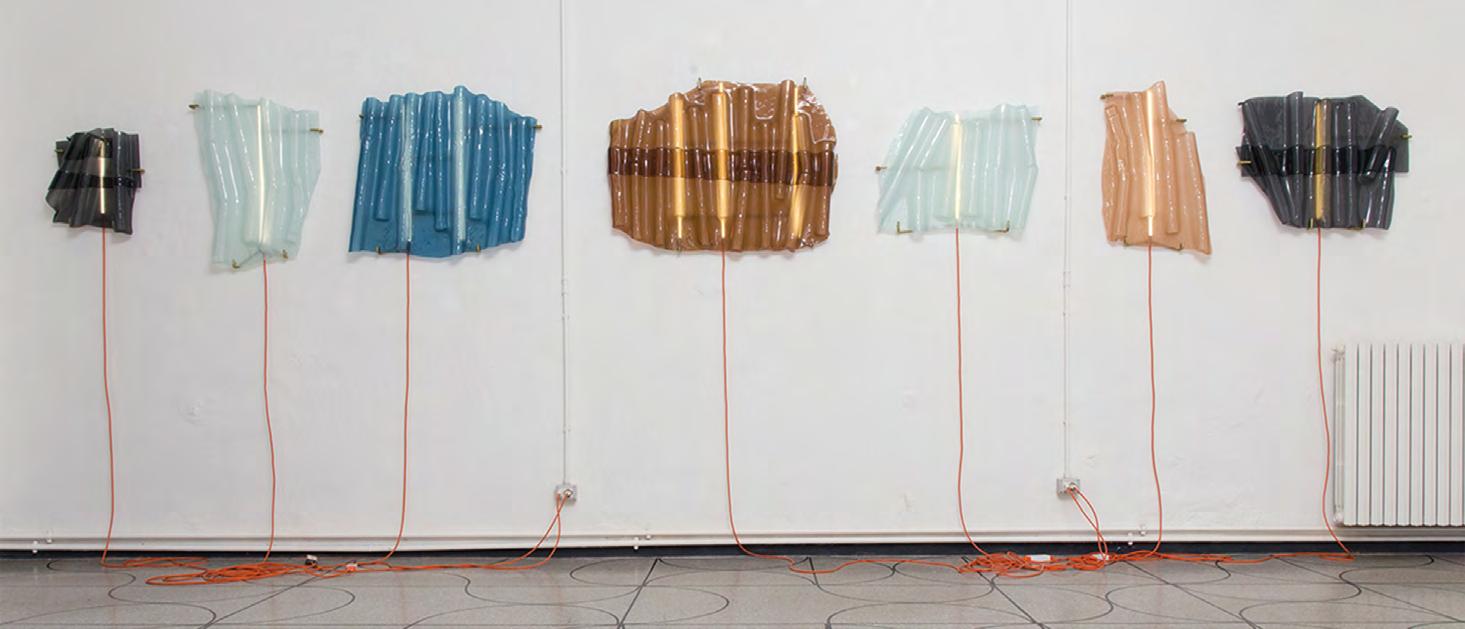
Fig. 04 Installation of Baracche collection at Camp Design Gallery in January 2017. Federico Floriani, courtesy Camp Design Gallery
certainly that of Maldonado explained in his fundamental essay Disegno Industriale: un riesame (1976), where design is seen as a social practice, and in Italy this connection is particularly strong.
The network of the creative industries is often composed by small and medium-sized enterprises (SMEs), a fundamental element of the Italian productive system. In the panorama of the today Expanded Design, the connection design–craft, as well as contemporary crafting and making modalities, is promising in the perspective of the development of Creative Industries and economies in Italy and abroad. Specifically, Italy is a good example where the collaboration between designers and craftsmen has a solid heritage with successful production innovations (Branzi, 2015). Design, artisanal skills, and industrial manufacture have a tradition of strong connections that brought important profitable achievements with as well a profound contribution in the construction of the Italian contemporary production identity better known as Made in Italy. In these circumstances, in the 70s and 80s experimental practices redefined the role of design, “marking the passage from design as a tool for the industry to a process of collective and social creativity” (Ferrara and Ban, 2022).
For these reasons, Italy plays internationally a key role thanks to the highlevel artisanal tradition and well-known materials that are now branded such as Carrara marble or Murano glass (Micelli, 2011). International artists and designers come all over the world for the production in Italy, and Italian artists and designers benefit from such a rich tradition in manufacturing too. The red thread that runs through the successful Made in Italy is still today the craftsmanship, a trait of Italian culture (Midal, 2019). However, within this flourishing artisanal tradition there is a well-defined threat which is the lack of technological innovation of the artisanal Italian network to keep up with digital tools (Micelli, 2016).
Thanks to new technologies and innovative approaches, craftsmanship developed on different paths of contemporary design. As Margolin stated (1989), with the recognition of design’s wider role in society, we started to make a place for design discourse within the larger debate about social and economic theories, notably those that centre on cultural transitions and sustainable productive development. As well, it is fundamental to consider the development of cultural identity through design practices and methods, traditional craftsmanship and productive process, with the valorisation of crafts practices to be functional for the rise of the creative economies and for the social organization of making (Sennet, 2008).
Conclusions
This paper wanted to tell a story as many can be found in the Italian field of the creative industries associated to the craft network.
In this case it has been underlined the intersections from the massively produced and standardised process of a material such as the float glass and the uniqueness of the final works realised by artist Paolo Gonzato. Bringing the material beyond the standard is what a good artist does.
What made Paolo Gonzato’s artistic process interesting was his capacity to explore contexts and situations in an original way, suggesting ideas and results to a material that has been rarely explored to express emotions and feelings. This ability to find innovative meanings to the material is the outcome of a continuous exercise of deepen knowledge associated to open mindedness to diversity and new perspectives. Thanks to the material approach, the artist had fundamental confrontations with the craft knowledge of uses and manipulation of the material itself, where its direct contact triggers solutions and possibilities. This free approach has been helped by the flexible craft network that Italy offers: small and medium enterprises that are opened to experience and test the process to realise a final work that normally wouldn’t have seen the light.
In this context the project can be analysed as a design experience of social, cultural, and economic mediation with groups of actors that interact within a situated process, as Maffei pointed (2010). Each design experience is unique and therefore not generalizable, it is built thanks to conditions such as shared knowledge, resources, local practices, and experiences of the actors involved. With this heritage the final product of the design experience, unfolds various layers of interaction with abstract subjects such as context, politics, cultural development, and intersectionality (Biggs, 2002). The project becomes a medium of cognitive contexts, conventions, and outcomes in the reality the designers and artists are immersed in1 .
1 Author Contribution: Conceptualization, Beatrice Bianco and Marinella Ferrara; writing—original draft preparation, Beatrice Bianco; review and editing, Beatrice Bianco, Marinella Ferrara. Project Contributions: Paolo Gonzato, Beatrice Bianco. Funding: This project was funded by Camp Design Gallery.
References
Biggs, M. (2002). The role of the artefact in art and design research. International Journal of Design Sciences and Technology, vol. 10, n. 2, pp. 19-24. Branzi, A (2015). Introduzione al design italiano. Una modernità incompleta. Milan: Baldini & Castoldi. Ferrara, M., Ban, S. (2022). Women and Maker Cultures. The Relevance of Technological Appropriation from History to Current Phenomena. In Oksala, T., Orel, T., Mutanen, A., Friman, M., Lamberg, J., Hintsa M. (ed.), Craft, Technology and Design. Hämeenlinna: JULKAISIJA – Häme University of Applied Sciences, pp. 168-197. Ferreira Nascimento, M. L. (2014). Brief history of the flat glass patent. Sixty years of the float process. In List, J. (ed.), World Patent Information, vol. 38. Amsterdam: Elsevier, pp. 50-56. Foucault, M. (1998). Estetica dell’esistenza, etica, politica. In Pandolfi, A., Revel, J., Dal Lago, A. (ed.), Dicts and Ecrits (first published in 1994). Giesecke, R., Clemente, R., Mitropoulou, I., Skevaki, E., Thiago Peterhan, C., Dillenburger, B. (2022). Beyond transparency: architectural application of robotically fabricated polychromatic float glass. In Brell Cockan, S. (ed.), Construction Robotics. Berlin: Springer. DOI: 10.1007/s41693-022-00071-6 Hooks, B. (1998). Elogio del margine. Razza, sesso e mercato culturale. Milano: Feltrinelli. Lunghi, C., Trasforini, M. A. (2010). La precarietà degli oggetti. Estetica e povertà. Roma: Donizelli. Maffei, S. (2010). Il progetto è una pratica clinica. La prospettiva del design. In Fabbri, T. M. (ed.), L’Organizzazione: Concetti e Metodi. Rome: Carocci, pp. 265-282. Maldonado, T. (1976). Disegno Industriale: un riesame. Milano: Feltrinelli. Margolin, V. (1989). Design Discourse: history, theory, criticism. Chicago: University of Chicago Press. Micelli, S. (2011). Futuro artigiano. L’innovazione nelle mani degli italiani. Venezia: Marisilio. Micelli, S. (2016). Fare è innovare. Il nuovo lavoro artigiano. Bologna: Il Mulino. Midal, A. (2019). Design by Accident: For a New History of Design. Berlin: Sternberg Press. Pilkington, L. A. B. (1969). Review lecture: the float glass process. Proceedings of the Royal Society of London, vol. 314, n. 1516, pp. 1-25. Quinz, E. (2020). Contro l’oggetto. Conversazioni sul design. Macerata: Quodlibet. Sennet, R. (2008). The craftsman. New Haven, London: Yale University Press. Taylor, A. (1979). Pilkington out to crack new markets. Financial Times. Uusitalo, O. (2014). Float Glass Innovation in the Flat Glass Industry. New York: Springer.

